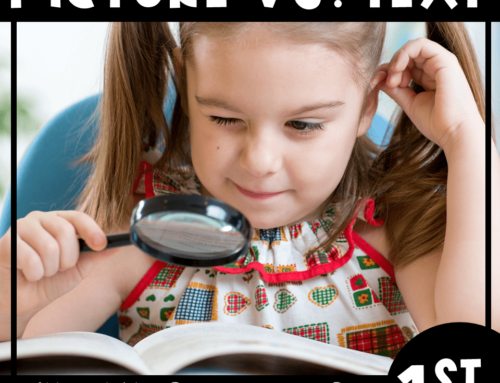A few months ago I did a Facebook Live discussing the Do’s and Don’ts of guided reading. You can check that video out here:
I think one of the things that surprised me most, and apparently many of my viewers, were my comments on whisper phones and round-robin reading. I suggested that students do not read aloud the text all at the same time when it is time for them to read independently. I want to focus on this a bit more, and go into some more detail.
Subvocalizing, or vocalizing, is when students read out loud when reading. Some students may whisper, and others may simply move their lips.
Many young and beginning readers tend to vocalize when reading. You may notice that during guided reading, you may ask students to read the text independently, and suddenly everyone is reading aloud and it is hard to hear each student!
One of my most favorite professional books is the book Yardsticks by Chip Wood.
(Please note that this is an affiliate link. I may make a commission when anything is purchased through this link.)
I used to read it each year before the school year started. I found it put me in the right “mindset” to prepare for what was developmentally appropriate from my students each year. This book breaks down what is developmentally appropriate for kids, each year, from ages 4-14. According to Wood, for seven-year-olds, “‘Silent reading’ is not yet silent- lots of whispering (vocalization) as children read.”
I generally start to encourage silent reading about mid-second grade. I do not make a make deal of it. I found that by preparing kids that were reading on grade level at the midpoint of the year, they easily made the transfer by the end of the school year. This followed Chip Wood’s advice, as many mid-second graders are still 7 years old. This way I could support them as they became more mature readers.
When I am reading a difficult recipe or a technical text, the first thing I do is turn off the radio or TV (I need total silence to concentrate! LOL! Am I alone???). Then, I usually read aloud the passage or text a few times until I am sure I “get” it.
So if I do this as an adult, why is subvocalizing such a big deal?
The biggest issue is that subvocalizing when reading slows the reader down. The reader will literally read at a slower pace. There is a lot of research supporting the correlation between fluency and comprehension. Basically, when a reader is fluent, their brain can focus more on understanding the story, instead of decoding the words. Subvocalizing can prevent the reader from reading fluently.
The next reason is a sad one, but a necessary evil. When standardized tests are given, students must read the passages “silently.” By scaffolding students to do this, they are not stunned when they have to read the entire test silently.
Another reason is that it makes the guided reading setting very distracting for your older students. Also, some of your kids who have developed some pretty slick coping strategies to hide their reading struggles can simply mimic the person beside them.
Like I mentioned above, I do not make a terribly big deal about it. I tell the kids, “Good readers read silently and think about the story in their brains. This helps them read more smoothly and helps them understand the story better. When we read everything out loud, our reading slows down and can make it hard to remember the story.”
Most kids will naturally make this jump when switching from a transitional to a fluent reader. To support kids reading on about a beginning to mid-second grade level, I will provide whisper phones.


(Please note that this is an affiliate link. I may make a commission when anything is purchased through this link.)
You can also make your own from PVC pipe from Home Depot or Lowes. Students can whisper into the phones. The sound will travel (like a telephone) to their ears, but will not be as loud or distracting to all the kids around them.
By about mid-second grade, I will stop using the whisper phones because I don’t want students to be overly reliant on them. Then, I gently remind kids to read silently when reading.
Often, kids will naturally make the progression by the end of the second to the middle of third grade. Students that are still reading aloud by this point, are generally reading below grade level and there may be bigger issues to tackle than subvocalization.
So, if kids are not reading out loud, all at the same time during guided reading, when do I hear and monitor them? My students read silently or using the whisper phones until I “tap in” with them. This means I literally touch their hand and ask them to read aloud a paragraph or two and then discuss it briefly with them. I am able to tap in with 2-3 kids per guided reading session. I take notes, so that the next session, I make sure to listen to the students I missed. I also can use these notes to help guide my teaching point.
Some may ask, “How can you make sure that the other kids are actually reading?” Easy! After students read the text and it is time to discuss the text as a group, I make sure to ask the students I didn’t tap in targeted questions to get a feel for their comprehension level.
Want to learn more about tapping in or how to promote fluency in guided reading (since kids aren’t reading out loud), just let me know in the comments and I will write another post since this is getting so long!
Click
here for this great pack of FREE math centers, plus get tips and updates from me!
Mandy Gregory is a 2007 and 2012 Teacher of the Year. She has taught Kindergarten- 4th grades in both the general education and inclusion settings. She is currently a 1st grade Special Education teacher. She is the owner and creator of Mandy’s Tips for Teachers website (www.mandystipsforteachers.com) and has over 13 years of teaching experience. She is married with two beautiful children.
















I have a fourth grader who can not read silently. Whisper phones help somewhat but nothing I have done is helping her overcome this. Any suggestions for this sweet girl would be appreciated.
The great all seo stargazes very useful to me thanks for sharing blog
Tefl Course Chiang Mai
Paid English Teaching Jobs Abroad
You should take a look at these exam learning tips that would help you to pass exams easily.